Reptile & Amphibian
News Blog
Keep up with news and features of interest to the reptile and amphibian community on the kingsnake.com blog. We cover breaking stories from the mainstream and scientific media, user-submitted photos and videos, and feature articles and photos by Jeff Barringer, Richard Bartlett, and other herpetologists and herpetoculturists.
Friday, May 29 2020
Happy Rattlesnake Friday! It may not be a rattlesnake, hot patootie it's a beauty!! This wild shot of a Death Adder from the Great Sandy Desert, uploaded by kingsnake.com user geoffcunningham assumes the traditional cobra pose for this photo! Be sure to tell them you liked it here! As always on Friday, we celebrate all of our venomous reptiles for their contribution to the world. It is our goal to help dispel the fears surrounding our beloved venomous creatures.

Upload your own reptile and amphibian photos at gallery.kingsnake.com, and you could see them featured here!
Thursday, May 28 2020
So simple and so beautiful. That is the black racer in our Herp Photo of the day, uploaded by kingsnake.com user ReptileProducts ! Be sure to tell them you liked it here!

Upload your own reptile and amphibian photos at gallery.kingsnake.com, and you could see them featured here!
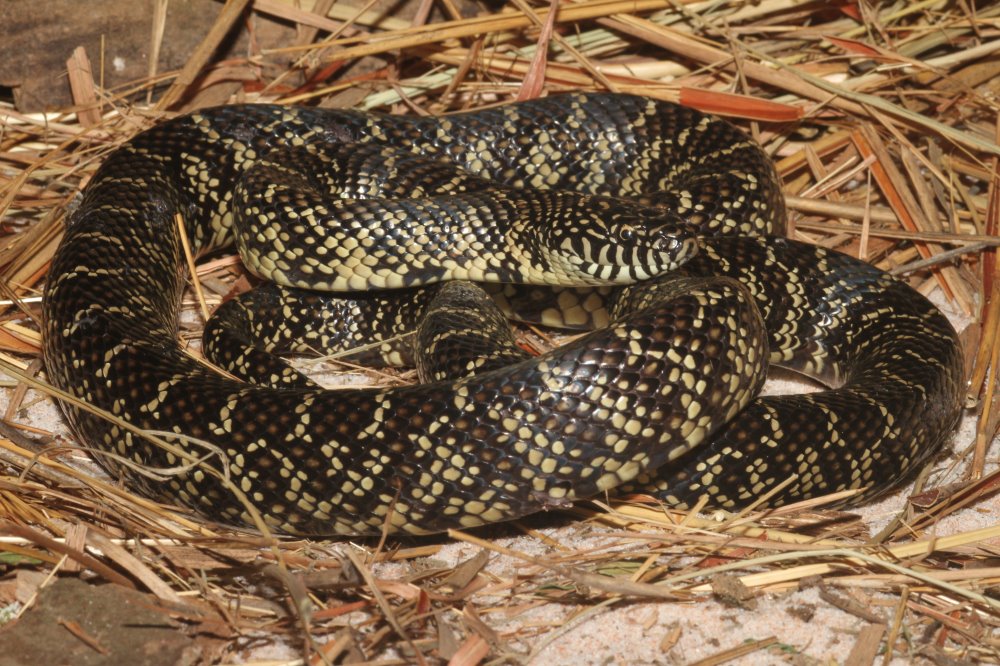
This is a typically colored Canefield Kingsnake.
There was a time when because of a more than ample food supply (garter snakes, water snakes, leopard frogs and rodents) drawn by the always full irrigation ditches these big busily patterned kingsnakes were actually fairly common. In the canefields they were so abundant that market hunters collected and made them a staple of the pet industry.
Canefields? What exactly are canefields. Well without overexpounding on the subject, I’ll simply say that over vast acres, actually miles, of southcentral Florida, where the Everglades once existed, thanks to King Sugar and an often uncaring government, there are now fields of sugarcane, and sugarcane = canefields.
And the kingsnakes that once thrived there are known by the vernacular of “Canefield kings.” Their actual name is Florida Kingsnake, Lampropeltis getula floridana, and their range now extends far southward from the canefields to the tip of the Florida peninsula. But herewith we are discussing only those kings from the canefields that surround Lake Okeechobee and extend a bit southward from there.
Today (2020), due to habitat polluted by the rampant use of insecticides and pesticides, as well as major alterations of the topography that has resulted in a huge reduction of the snake’s prey species and cover in the canefields, it would seem that these beneficial snakes have gone from common to rare. This is an abrupt change in only a 3 or 4 decade time span.
As hatchlings these kingsnakes are quite dark in overall color, with often barely discernable crossbands and even more difficult to see light speckles on some of the dark scales. Colors lighten and patterns become more visible as this kingsnake grows. Adults have a light brown ground color with many scales edged in black, and with irregular off-white dorsal banding. Lateral markings are varied. Some are merely extensions of a dorsal band, some appear like a rough edged triangle, others are just whitish scales scattered haphazardly over the snake’s side. The venter is usually yellowish with yellowish checkers. The average length of predominantly terrestrial, primarily diurnal, snake is 3 ½ to 4 ½ feet. However they occasionally exceed 5 feet.
Clutch size for this kingsnake is usually between 5 and 20 eggs. Hatchlings measure between 9 and 12 inches in length.
Currently difficult to find, I must wonder whether the next decade or two will bring extirpation or renewed abundance to this iconic kingsnake. We’ll hope for the best, of course.
Continue reading "Canefield Kings"
Wednesday, May 27 2020
This vibrant Cape Gopher Snake ( Pituophis catenifer vertebralis) in our herp photo of the day, uploaded by kingsnake.com user pitparade will brighten your Monday for sure! Be sure to tell them you liked it here!

Upload your own reptile and amphibian photos at gallery.kingsnake.com, and you could see them featured here!
Tuesday, May 26 2020
It is hard to not see beauty when you look at the Asian Vine Snake ( Ahaetulla prasina) our Herp Photo of the Day, uploaded by kingsnake.com user 13lackcat! Be sure to tell them you liked it here!
 Upload your own reptile and amphibian photos at gallery.kingsnake.com, and you could see them featured here!
Upload your own reptile and amphibian photos at gallery.kingsnake.com, and you could see them featured here!
Monday, May 25 2020
What makes a Monday more tolerable? A baby box turtle hatching like the one in our Herp Photo of the day, uploaded by kingsnake.com user norristhenut . Bonus shout out for World Turtle Day, which we missed this weekend! Be sure to tell them you liked it here!

Upload your own reptile and amphibian photos at gallery.kingsnake.com, and you could see them featured here!
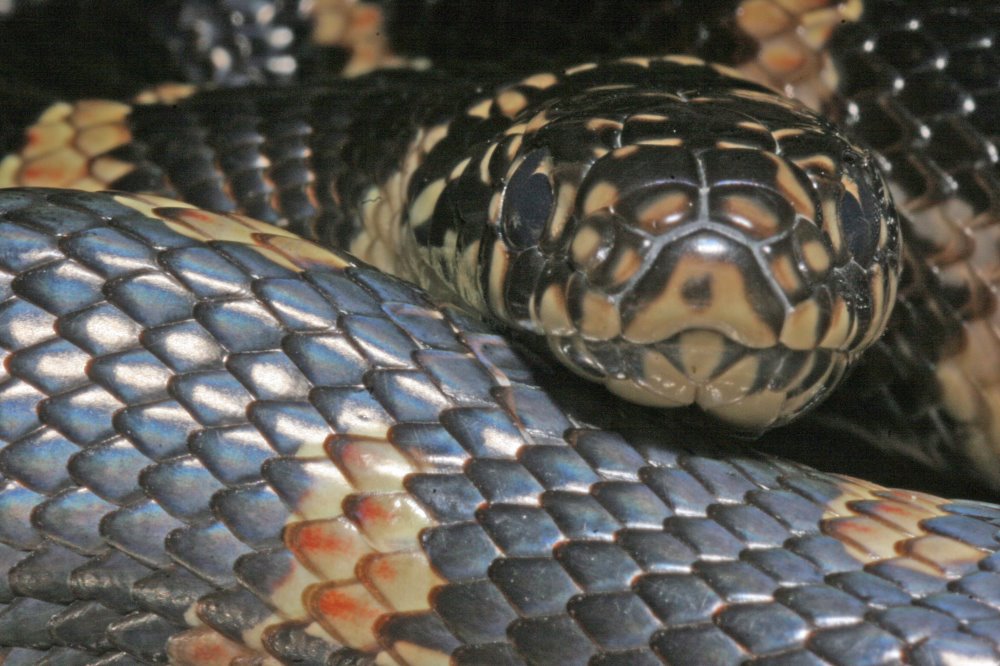
Hatchling Eastern Kingsnakes often have a bit of orange laterally.
Jake and I wanted to see eastern kingsnakes, Lampropeltis g. getula, There are a few places where this subspecies can be found in northern Florida but Jake insisted that we’d have a better chance in Georgia. I’m easily swayed, so on a Sunday morning, about the time the midwinter sun was thinking about rising so we piled camera and us into the car and headed northward. Once there we rendezvoused with Noah and his dad, Dave, who knew this area far better than we, and began the hunt.
Noah and Dave really did know the area. They guided us to one abandoned ramshackle shack, and the fallen roofing tins associated with such locales, after another. Many harbored rodent nests but none sheltered snakes—of any kind. Until, sometime about midday a flipped sheet of tin divulged—SNAKE!—but darn, it was only a hatchling southern black racer, Coluber constrictor priapus. The racer home was carefully replaced and we moved on.
We moved from tin pile after tin pile (called flip spots) but no other snakes. We moved on to a tangle of fallen and a few still standing dead pines. We searched high and we searched low. Just as we were about to abandon efforts, Dave called out SNAKE! He had chanced upon a juvenile gray rat snake, Pantherophis obsoletus spiloides. We actually took pix of this one. In our minds it wasn’t as good as a king, but it WAS better than a baby racer (we never told the racer this).
Time was moving on but Noah suggested one more spot. He had never found a king at the suggested spot but he felt it had potential. Off we went and 30 minutes later we stopped beside 3 pieces of plastic. Jake, Noah, and Dave piled out. I’m a lot slower these days—I watched. Beneath the first piece of plastic, nothing. Ditto on plastic number 2. But plastic piece number 3? It held in its folds the prize of the trip. As Noah happily exclaimed “The crown jewel of a fun day of tin flipping, a chunky female Eastern King.” I’ll simply add that it was scale perfect, very well nourished, and just entering ecdysis.
Photos were taken, the snake was replaced, we shook hands, hopped in the cars, and in the proverbial cloud of smoke (actually flying sand) we closed out the great kingsnake hunt.
Continue reading "The Search for a King"
Friday, May 22 2020
Happy Rattlesnake Friday! The detail in this headshot of an Atrox is amazing in our photo of the day uploaded by kingsnake.com user scserpents ! Be sure to tell them you liked it here! As always on Friday, we celebrate all of our venomous reptiles for their contribution to the world. It is our goal to help dispel the fears surrounding our beloved venomous creatures.

Upload your own reptile and amphibian photos at gallery.kingsnake.com, and you could see them featured here!
Thursday, May 21 2020
What a gorgeous little Ameiva in our herp photo of the day, uploaded by kingsnake.com user Agata ! Be sure to tell them you liked it here!

Upload your own and photos at gallery.kingsnake.com, and you could see them featured here!
Wednesday, May 20 2020
So simple and so beautiful. That is the black racer in our Herp Photo of the day, uploaded by kingsnake.com user ReptileProducts ! Be sure to tell them you liked it here!

Upload your own reptile and amphibian photos at gallery.kingsnake.com, and you could see them featured here!
Tuesday, May 19 2020
What wonderful field find in Mexico of this Lyre Snake our herp photo of the day uploaded by kingsnake.com user Chuck_Ch ! Be sure to tell them you liked it here!

Upload your own reptile and amphibian photos photos at gallery.kingsnake.com, and you could see them featured here!
Monday, May 18 2020
This Helmeted Iguana or Hernandez's helmeted basilisk ( Corytophanes hernandezi) in our Herp Photo of the day, uploaded by kingsnake.com user chrish is quite the break from our usual. What a regal and stunning animal! Be sure to tell them you liked it here!

Upload your own reptile and amphibian photos at gallery.kingsnake.com, and you could see them featured here!
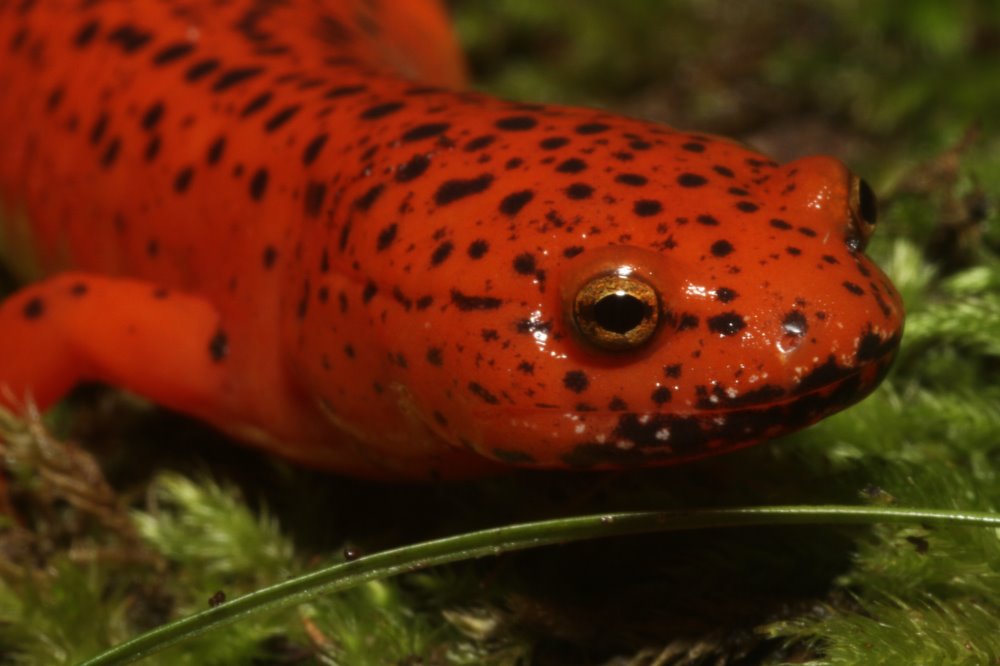
Black-chinned red salamander
It had been an arduous drive from Florida to Tennessee. Traffic had been and continued to be heavy, the weather was warm, and scattered thunderstorms of considerable intensity had slowed traffic a bit. Drivers, often volatile, were inclined to be even more so when impeded in the slightest. We had long ago left FL behind us, a bit more recently said goodbye to Georgia, and were now bidding adieu to South Carolina. The destination of Cherokee, NC, was not too distant. As dusk enveloped us we were greeted at the NC state line by more thunder, lightning, and torrential rain. If this would just continue, the night, now hovering at 70F, should cool a bit more and be ideal for amphibian movement. A half hour later the sky was nearly clear, we had found a hotel, were lamenting the sun slowly dipping behind the curvature of the earth, had a bite to eat, and decided to continue for another 30 miles to our destination. At least traffic had thinned.
Roadsides were wet and we hope there was moisture enough to induce amphibian activity. But 30 minutes later, as thunder rumbled anew, we knew we wouldn’t have to worry. Lightning began strobing from cloud to cloud. First a gentle shower wet the woods and road, tyhen harder, and harder still. It was dark and the traffic had dwindled until there wasn’t a car in sight.
Spring peeper, Pseudacris crucifer, then another. WhoopsEurycea longicauda—a wood frog, Rana sylvatica,-missed it. An elk crossed the road. Was that a worm. Quick stop. No worm, but a Blue Ridge 2-lined salamander, Eurycea wilderae. And then another and another. Then a long-tailed salamander, Eurycea longicauda . More 2-lines and peepers. The Oconoluftee River was roaring over submerged rocks. Then 3 large salamanders in rapid succession—1 Black-chinned red, Pseudotriton ruber schencki, and 2 Blue Ridge spring salamanders, Gyrinophilus porphyriticus danielsi. Had to move over for a few cars. Another long-tail. And so it went for the next couple of hours. Then on a whim I turned into a darkened overlook, shuffled a few fallen leaves, and voila—a red cheeked salamander, Plethodon jordani. At each stop I took several photos, my flash vying with the lightning bolts, trying all the while to keep the camera dry. Managed to almost do that. New batteries needed in both camera and strobe.
Time to call it a night. Couldn’t have been better. Birding and (hopefully) bear watching tomorrow.
Motel, here we come.
Continue reading "A Rainy Spring Night in Tennessee"
Friday, May 15 2020

In the most recent Covid-19 Relief package is a potential reversal of the USARK federal lawsuit victory by reinstating the ban on interstate transportation of species listed as injurious under the Lacey Act. That victory allowed for captive bred animals to be transported across state lines. This impacts the so called "Big 5" but also several Salamander species. We have added the USARK public notice after the bump.
Continue reading "ALERT: Wildlife-Borne Disease Prevention Act (Federal"
Happy Rattlesnake Friday! This beautiful pair of Copperheads are just things of beauty in our photo of the day uploaded by kingsnake.com user ShadowChaser ! Be sure to tell them you liked it here! As always on Friday, we celebrate all of our venomous reptiles for their contribution to the world. It is our goal to help dispel the fears surrounding our beloved venomous creatures.

Upload your own reptile and amphibian photos at gallery.kingsnake.com, and you could see them featured here!
Thursday, May 14 2020
What a lovely field shot of a Northern Yellow-faced Turtle hatchling in our herp photo of the day, uploaded by kingsnake.com user frilly ! Be sure to tell them you liked it here!

Upload your own and photos at gallery.kingsnake.com, and you could see them featured here!
Wednesday, May 13 2020
Love is in the air with this pair of Gran Canaria giant lizards ( Gallotia stehlini) in our Herp Photo of the day, uploaded by kingsnake.com user John-C . Be sure to tell them you liked it here!

Upload your own reptile and amphibian photos at gallery.kingsnake.com, and you could see them featured here!
Tuesday, May 12 2020
What an awesome field shot of a Blue Spiny Lizard in our herp photo of the day, uploaded by kingsnake.com user arkherps ! Be sure to tell them you liked it here!

Upload your own and photos at gallery.kingsnake.com, and you could see them featured here!
Monday, May 11 2020
The colors on this Madison County locale corn snake in our Herp Photo of the day, uploaded by kingsnake.com user draybar are screaming! Be sure to tell them you liked it here!

Upload your own reptile and amphibian photos at gallery.kingsnake.com, and you could see them featured here!
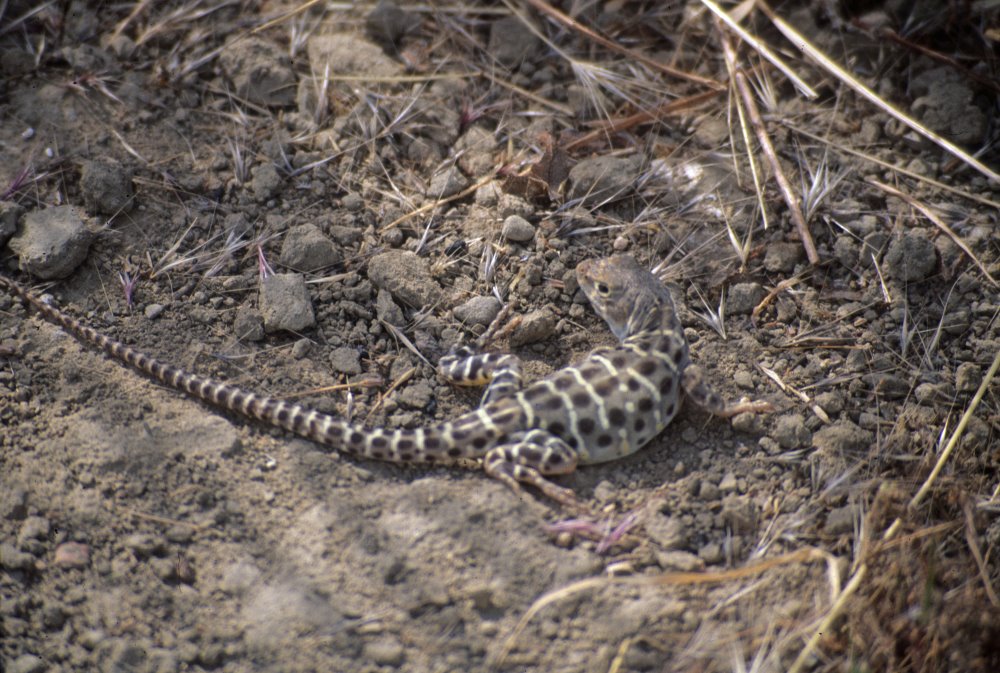
A pretty female Blunt-nosed Leopard Lizard.
Finding the creature, the Blunt-nosed leopard lizard, Gambelia sila, a Federally Endangered species.took several hours of concerted searching by Tom Tyning and me. We knew sila to be a resident of California's Carizzo Plains, and it was in that area that we centered our efforts. We had been told "you'll see 'em sunning on the rocks." But, I had failed to find out exactly where these rocks were. So we looked, we drove, we hiked, and we looked some more. We finally did find a few rocks along a dried streambed, but only side-blotched lizards and California ground squirrels seemed resident there. We traipsed through lush mountain meadows, yellowed with the blooms of California poppies, and low, drouth-browned grasslands. We found gopher snakes galore. We found a southern Pacific rattler, and eventually, after a full day of searching, we found a small population of the leopard lizards. On rocks? Heck no! There wasn't a rock in sight!
As we were driving slowly down a rutted sand road, Tom quietly said "I just saw a lizard."
My query was "What kind?"
"I don't know, but it was bigger than an Uta (side-blotched lizard)."
"Where did you see it?"
"In the middle of the road. I think it went down a hole."
So I stopped, and backed up.
Yep, there was a hole there. And I guess my right tires had gone directly over it.
So I parked the car, and we got out, and sat on the ground some dozen feet away from the hole.
After several minutes of sitting a tiny nose poked above the rim of the hole. A few minutes more and an eye emerged. It was a blunt-nose, no question about that. I congratulated Tom on seeing the creature. Now, could we get photos?
The short answer was “yes, we could.” And we did.
After another 15 minutes the lizard decided we were nothing more than misplaced dirt-clods and emerged from his hole.We both got pix. Mission accomplished but not yet over. Just as dark clouds began covering the face of the late afternoon sun, we happened across a prettily colored female leopard lying quietly on the side of the trail. We both got photos there and before we left the area we had succeeded in getting pix of several more.
An iffy day had become a banner day. Thanks, Tom.
Continue reading "Blunt-nosed Leopard Lizards"
Friday, May 8 2020
Happy Rattlesnake Friday! This stunning Guarico Rattlesnake, uploaded by kingsnake.com user robnimmo is a thing of beauty to behold! Be sure to tell them you liked it here! As always on Friday, we celebrate all of our venomous reptiles for their contribution to the world.

Upload your own reptile and amphibian photos at gallery.kingsnake.com, and you could see them featured here!
Thursday, May 7 2020
May this wild Alligator on the Peace River in Florida in our Herp Photo of the day, uploaded by kingsnake.com user JonathanH bring you a peaceful monday. Be sure to tell them you liked it here!

Upload your own reptile and amphibian photos at gallery.kingsnake.com, and you could see them featured here!
Wednesday, May 6 2020
This Chuckwalla is feeling the warmth of the sun in our Herp Photo of the day, uploaded by kingsnake.com user NDokai ! Be sure to tell them you liked it here!

Upload your own reptile and amphibian photos photos at gallery.kingsnake.com, and you could see them featured here!
Tuesday, May 5 2020
Take a few moments today to follow the lead of this Giant Day Gecko in our Herp Photo of the day, uploaded by kingsnake.com user crazyrhacos and give yourself some time to relax! Be sure to tell them you liked it here!

Upload your own reptile and amphibian photos at gallery.kingsnake.com, and you could see them featured here!
Monday, May 4 2020
This Pine Snake looks so velvety smooth in our herp photo of the day, uploaded by kingsnake.com user Jack77 ! Be sure to tell them you liked it here!

Upload your own reptile and amphibian photos at gallery.kingsnake.com, and you could see them featured here!
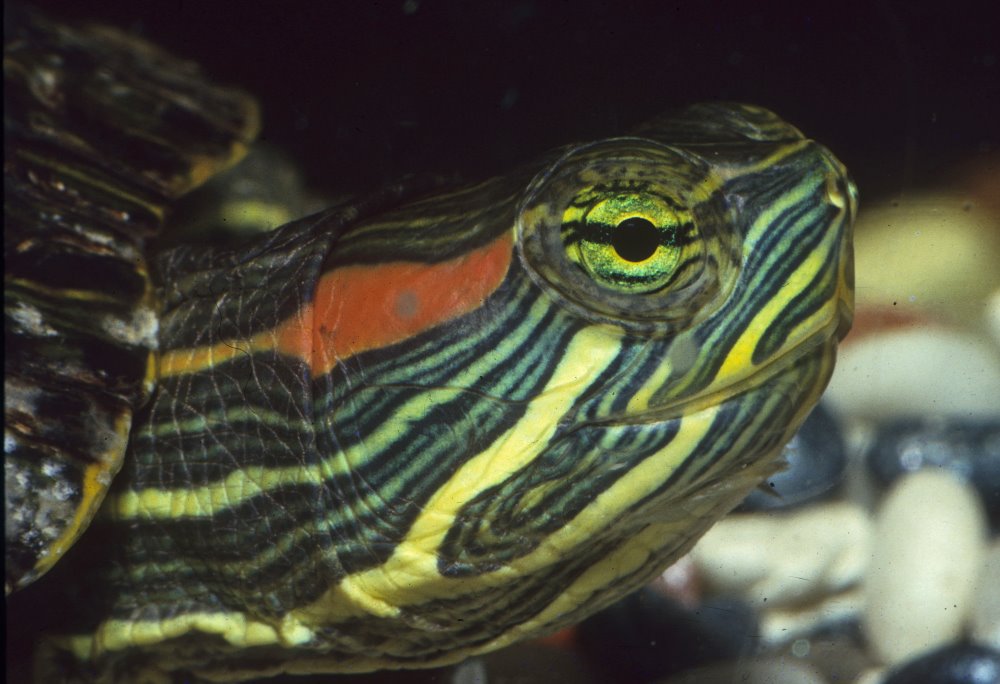
A normal colored half grown red-ear.Thanks to aid and abetting by the human race (and more specifically the pet trade) the Red-eared Slider, Trachemy scripta elegans, is now quite probably the most numerous and widespread turtle in the world. Originally known only from the Gulf Coast and Mississippi River Valley states, because of its popularity as a pet turtle and the ability of releasees and escapees to adapt to new and different temperature and habitat regimes, this turtle is now known far outside of its one-time range in the USA. It is now a well-known species in many other countries as well. Some of these foreign ports of landing and stability are ponds, lakes, and other waterways in Australia, Europe, Great Britain, South Africa, the Caribbean Islands, Israel, Bahrain, the Mariana Islands, Guam, southeast and far-east Asia, and several Central and South American countries. Where they are present they are usually easily observable, both while swimming and basking.
Although this species has been produced in many temperature and genetically influenced colors and patterns we are basically talking about normalcy here. Except for the yellow plastron hatchlings are green with lighter green to yellow markings and (usually) a red ear-stripe. The albinos are, of course, white with reddish ear stripes and occasionally additional facial striping.There are 6 pairs of darker ocelli on the plastron. And in keeping with turtles in this species complex in general, as males grow and age a suffusion of melanin darkens them. Some individuals become so dark that no other colors or markings remain visible. All colors can vary in intensity.
The red-eared slider is the same little turtle, the “little green turtle,” that was sold last century in the pet departments of almost every 5 and dime and department store in the nation. They, and the totally useless little plastic turtle bowls (adorned with a plastic palm tree) were also sold in the various countries where these turtles are now present and are considered an invasive species. The primary food then suggested for the turtles was dried ant eggs! If cared for as then directed soft shells, swollen and closed eyes were soon followed by the death of the turtle. On the other hand, if by either accident or intent the turtle was given ample room to grow and exercise, to swim and to bask, and provide with a diet of greens and fresh animal matter (worms, fish etc.), a lifespan of 25 to 60 years may be attained.
Adult at 6 to 9 inches in carapace length, an occasional individual may exceed 12”. Females are usually the larger gender. Determining gender of adults is an easy task. Not only do females have a short and rather slender tail but they have short claws on their forefeet. Males, on the other hand, have a long and thick tail and long claws on their forefeet. The elongate claws of the males are instrumental in courtship and may also help determine dominance over other males by the strongest and most persistent male. Sexing hatchlings is, in contrast, impossible.
A late winter to early summer breeder, the red-ear can have up to 6 clutches of from 4 to 25+ eggs each season. Clutch size depends on the health and size of the female. Based on temperature and ground moisture incubation varies from 2 to 3 ½ months.
Continue reading "The Red-eared Slider 101"
Friday, May 1 2020
Happy Rattlesnake Friday! This certainly is not a rattlesnake, but it is a beautiful venomous creature. What a great close up of a Gaboon Viper, uploaded by kingsnake.com user magnum26 is full of sassy and potentially life-saving venom! Be sure to tell them you liked it here! As always on Friday, we celebrate all of our venomous reptiles for their contribution to the world.

Upload your own reptile and amphibian photos at gallery.kingsnake.com, and you could see them featured here!
|



